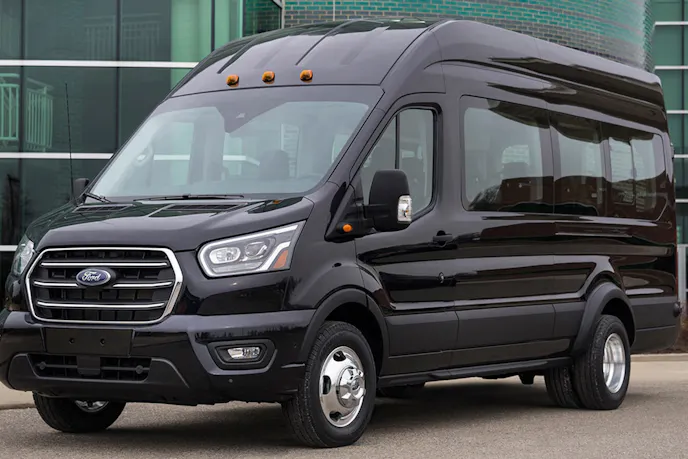If a Ford Transit van sounds like a diesel—yes, it could be. It’s hard to believe, but about ten years ago, many of our favorite trucks and SUVs were getting diesel’fied—including the full-size Ford Transit van (which had essentially replaced the E-Series). The 3.2-liter Power Stroke diesel engine was offered in the Ford Transit from 2015 through 2019 in the United States. While the Transit remains in production today, the diesel engine option was quietly phased out starting with the 2020 model year as Ford moved toward EcoBoost gas engines and eventually electrification with the E-Transit.

The Engine: 3.2-liter Power Stroke Inline-Five
The compression-ignition unit that powered the Ford Transit was the 3.2-liter Power Stroke inline-five, also known globally as the Duratorq 3.2. It made 185 hp and 350 lb-ft of torque (that’s more torque than the current Mercedes-Benz Sprinter’s high-output 2.0-liter) and was mated to a six-speed automatic transmission. This five-cylinder turbodiesel was part of Ford’s modular diesel engine family.

Other Applications
The 3.2-liter Duratorq wasn’t unique to the Transit. It also powered global-market versions of the Ford Ranger, Ford Everest SUV, and various military and fleet vehicles overseas. In the United States, however, it remained exclusive to the Transit.

Enter EcoBlue: The Next Generation of Ford Diesels
After phasing out the Duratorq engines, Ford launched its new EcoBlue diesel engine family in 2016 in Europe. These were advanced, smaller-displacement diesels featuring aluminum blocks, high-pressure fuel injection, low-friction internals, and optimized emissions performance.
While the 2.0-liter EcoBlue engine eventually replaced the 2.2-liter and 2.4-liter Duratorq diesels in many global Transit and Ranger models, EcoBlue diesels were never offered in the U.S. market, where diesel demand was more limited and emissions compliance was stricter. Hence, our Transit never got the EcoBlue, instead retiring from diesel altogether after the Duratorq.
And to answer a common point of confusion: no, the Mercedes-Benz Sprinter has never used Ford’s EcoBlue engines. The Sprinter uses Mercedes’s own diesel powerplants, like the 2.1-liter OM651 and later the 2.0-liter OM654 four-cylinder diesels, as well as the 3.0-liter OM642 V6. While both Ford and Mercedes offer diesel vans, they are powered by entirely different engine families.

Why Was The Diesel Transit Van Discontinued
The diesel Transit was discontinued due to tightening emissions regulations, changing fleet buyer preferences, and Ford’s strategic pivot toward gasoline and electric powertrains. The 3.5-liter EcoBoost V6 provided similar torque with better acceleration, lower emissions, and fewer DEF-related headaches. As demand shifted, particularly in North America where diesel vans were niche, Ford pulled the plug.

Was The Diesel Transit Van Any Good?
Absolutely—for the right buyer. The diesel Transit wasn’t flashy, but it was dependable. Owners loved its torquey, long-lasting engine, real-world fuel economy (often in the high teens to low 20s mpg), and global pedigree. It wasn’t as quick as the EcoBoost or as quiet as a gas V6, but diesel aficionados continue to seek out used examples, especially for camper van conversions and delivery applications. With proper maintenance, these vans are known to run for hundreds of thousands of miles—just what you’d expect from a Power Stroke.
You might also like
Audi’s Updated 3.0-liter V6 TDI Diesel For The Q5 And A6 Is Here... But Not.
Audi has just unveiled its updated 3.0L V6 TDI for the Audi Q5 and Audi A6, engine code EA897evo4. This Audi V6 TDI isn't for the U.S.


